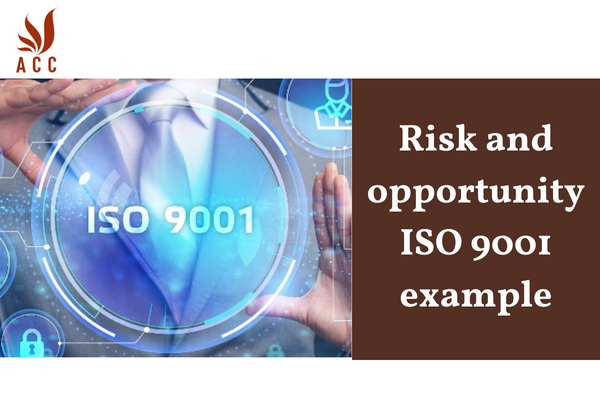Risk and opportunity management is an essential part of any successful quality management system (QMS). ISO 9001, the international standard for QMS, requires organizations to identify, assess, and manage risks and opportunities that could impact their ability to meet their quality objectives.
In this article, we will discuss the importance of risk and opportunity management in ISO 9001, and provide some examples of how organizations can implement these concepts. We will also discuss the potential benefits of effective risk and opportunity management, such as improved quality, increased efficiency, and reduced costs.

Risk and opportunity ISO 9001 example
1. Introduction
Risk and opportunity are two important concepts in the ISO 9001 quality management system. Risks are events or situations that can have a negative impact on the organization's ability to meet its objectives. Opportunities are events or situations that can have a positive impact on the organization's ability to meet its objectives.
2. Examples of risks
Some examples of risks that can be identified and managed in an ISO 9001 quality management system include:
- Changes in customer requirements
- Changes in legislation or regulations
- Changes in technology
- Natural disasters
- Human error
- Supply chain disruptions
3. Examples of opportunities
Some examples of opportunities that can be identified and exploited in an ISO 9001 quality management system include:
- New market opportunities
- New technologies
- Partnerships with other organizations
- Cost savings
- Improved efficiency
4. Risk and opportunity management process
The ISO 9001 quality management system requires organizations to identify, assess, and control risks and opportunities. The risk and opportunity management process should be documented and implemented as part of the organization's overall quality management system.
The following steps are involved in the risk and opportunity management process:
- Identification
The first step is to identify all potential risks and opportunities that could impact the organization. This can be done by brainstorming, using risk assessment tools, or conducting surveys.
- Assessment
Once all potential risks and opportunities have been identified, they need to be assessed in terms of their likelihood and impact. This will help the organization to prioritize the risks and opportunities that need to be addressed.
- Control
The risks and opportunities that have been assessed as being significant need to be controlled. This can be done by implementing preventive or corrective actions.
5. Conclusion
Risk and opportunity management is an essential part of any ISO 9001 quality management system. By identifying, assessing, and controlling risks and opportunities, organizations can improve their ability to meet their objectives and achieve success.
Here are some additional examples of risks and opportunities that can be identified and managed in an ISO 9001 quality management system:
Risks
- Customer dissatisfaction
- Product recalls
- Legal action
- Financial losses
- Reputational damage
Opportunities
- Increased market share
- New product development
- Expansion into new markets
- Improved customer service
- Reduced costs
By considering a wide range of risks and opportunities, organizations can ensure that they are taking steps to protect their interests and achieve their goals.
6. Frequently asked questions
-
What is the definition of risk and opportunity in ISO 9001?
In ISO 9001, risk is defined as the effect of uncertainty on objectives, while opportunity is a set of circumstances that can lead to improvement or positive outcomes.
-
How does ISO 9001 address the identification of risks and opportunities?
ISO 9001 requires organizations to determine risks and opportunities that need to be addressed to ensure the quality management system can achieve its intended outcomes and continual improvement.
-
Can you provide an example of a risk in the context of ISO 9001?
An example of a risk could be a potential supplier's inability to deliver materials on time, affecting the production schedule and, subsequently, the delivery of products to customers.
-
What measures can organizations take to mitigate risks according to ISO 9001?
Organizations can implement preventive actions, contingency plans, and regularly monitor and review potential risks to minimize their impact. This aligns with ISO 9001's focus on proactive risk management.
-
How are opportunities managed under ISO 9001?
ISO 9001 encourages organizations to identify opportunities for improvement, innovation, and enhanced customer satisfaction. Proactive measures can be taken to harness these opportunities for the benefit of the quality management system.
Nội dung bài viết:






Bình luận